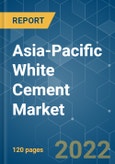The market for White Cement in Asia-Pacific is expected to grow at a CAGR of over 2% during the forecast period. Major factors driving the market studied are growing demand from the construction industry in Asia-Pacific and increasing demand for precast concrete. On the flipside, high production cost is the major restraint, which is expected to hinder the growth of market.
Key Highlights
- Growing investment on infrastructure in ASEAN countries is expected to offer various lucrative opportunities for the growth of market.
- By type, the type 1 segment accounted for the largest share, owing to its properties to provide brilliant color for concrete or mortar as it is ideal for a variety of architectural projects
- By application, non-residential segment accounted for the largest share owing to increasing demand for white cement from commercial, industrial and infrastructure applications.
- By Country, China is expected to dominate the market during the forecast period.
Key Market Trends
Growing Demand from the Construction Industry in Asia-Pacific
- China has the world’s largest construction market and is the world’s largest cement manufacturer. Though there is a slight drop in the growth rate, the construction industry in China has still witnessed a significant growth rate over the past few years. According to the National Bureau of Statistics of China, the construction output value in the country increased from CNY 9.6 trillion in 2010 to CNY 24.84 trillion in 2019.
- India is the second-largest cement manufacturer in the world. The major white cement manufacturers in the country include JK Cement and Ultratech Cement. The demand for white cement in the country is expected to be boosted by the growing infrastructure development in the country. Nearly 9% of India’s GDP is spent on Infrastructure services. The Government of India gave an enormous momentum to the infrastructure sector by allocating INR 5.97 lakh crore (USD 92.22 billion), under the Union Budget 2018-2019.
- Additionally, investments of USD 31,650 billion have been proposed by 99 cities under their smart cities plan. 100 smart cities and 500 cities are likely to invite investments worth INR 2 trillion in the next five years.
- Furthermore, The Indonesian construction industry witnessed significant growth in recent years. The GDP from construction in Indonesia increased from MYR 1,041.95 trillion in 2014 to around MYR 1,562.3 trillion in 2018. The Indonesian building construction has witnessed a significant growth in recent years owing to the increasing population and growing urbanization.
- Hence, the aforementioned trends in the construction industry of Asia-Pacific are driving the demand for white cement in the market studied.
China to Dominate the Market
- In Asia-Pacific, China is the largest economy, in terms of GDP. The country witnessed about 6.1% growth in its GDP during 2019, even after the trade disturbance caused due to its trade war with United States.
- In China, the construction industry grew at a strong pace in 2019, even though the growth slowed down during the year, as compared to 2018. The construction sector has supported the economic growth in the country, while the United States-China trade war affected the performance in other industries, such as automotive and electronics.
- Such increase in the number of infrastructure project approvals during 2019 is likely to stimulate infrastructure spending over the next two years. During 2019, a total of about 300 major construction projects were announced in Beijing, including 100 projects to improve the livelihood of the public, 100 projects for high-end technological industries, and 100 infrastructure projects. These projects are expected to attract in total of about USD 35 billion.
- The government more than doubled the investment on large-scale infrastructure projects approved during 2019, as compared to CNY 374.3 billion in 2018 (USD 52.8 billion), in order to ensure steady growth of the economy. Within the first nine months of 2019, the National Development and Reform Commission (NDRC) approved about 21 projects worth more than CNY 764.3 billion (USD 107.8 billion), which accelerated infrastructure investment by 4.5%.
- In 2020, the country still plans to rely on state infrastructure spending to avert the anticipated scenario of sharper slowdown. In this regard, the country strategizes to boost infrastructure investment and offer more special bonds.
- The local governments in the country are permitted to issue special bonds worth around CNY 3 trillion (USD 426.20 billion) in 2020, for funding infrastructure projects, including CNY 1 trillion, which is front-loaded to this year. Furthermore, the central bank is likely to ease its policy to lower the corporate funding costs and encourage lending. Besides, there are numerous airport projects in line for construction within the forecast period.
- As of May 2019 statistics, China holds around 235 airports, which the government plans to increase airports to 260 by 2020. In this regards, some of the airport construction projects, which are either in development or in the planning stage, include Beijing Capital International Airport, Chengdu Shuangliu International Airport, Chongqing Jiangbei International Airport, Guangzhou Baiyun International Airport, and Xianyang International Airport expansion. Besides, the government’s long-term targets remain around 450 airports for the country by 2035.
- Hence, all such construction investments and projects planned in the country are projected to drive the domestic consumption of the white cement market over the forecast period.
Competitive Landscape
The white cement market in Asia-Pacific is consolidated, with the top five players accounting for major share of the market. The key players in the market include, JK Cement Ltd, SOTACIB, India Cements Ltd, and Aditya Birla Group, and Cementir Holding N.V.
Additional Benefits:
- The market estimate (ME) sheet in Excel format
- 3 months of analyst support
This product will be delivered within 2 business days.
Table of Contents
Companies Mentioned (Partial List)
A selection of companies mentioned in this report includes, but is not limited to:
- Aditya Birla Group
- Almatis
- Ambuja Cements Ltd
- Cementir Holding N.V.
- India Cements Ltd
- JK Cement Ltd
- Royal El Minya Cement
- SOTACIB
Methodology

LOADING...








